Performance Aircraft Unlimited Extra 300SP
 Written by Andrew Griffith
A purpose-built electric aerobat
Product review
As seen in the January 2018 issue of Model Aviation.
Written by Andrew Griffith
A purpose-built electric aerobat
Product review
As seen in the January 2018 issue of Model Aviation.
Bonus Video
Specifications
Model type: 3-D and precision aerobat Skill level: Intermediate Wingspan: 60 inches Wing area: 655 square inches Wing loading: 20-24 ounces per square foot Airfoil: Symmetrical Length: 57 inches Weight: 5.5 to 6.5 pounds Power system: 60-size electric Radio: Full-range, four-channel minimum; five-channel recommended Construction: Built-up balsa and light plywood Covering/finish: UltraCote and paint Price: $279.99Test-Model Details
Motor used: PAU 6S 540 Kv brushless motor ESC: Castle Creations Talon 90 Propeller: Xoar 15 x 8 Flight battery: Venom Fly 3,600 mAh 50C LiPo Radio system: Spektrum DX18G2 transmitter; Spektrum AR6600T receiver; four MKS HV747 servos Ready-to-fly weight: 6 pounds, 2 ounces Wing loading: 21.5 ounces per square foot Flight duration: 5 minutesPluses
• Highly aerobatic and flies bigger than its size. • Excellent color scheme with good contrast. • Performs 3-D and precision maneuvers well. • Large hatch for easy access to change flight batteries. • Better scale outline than many Extra models.Product Review
Designed by Walter Extra for international aerobatic competition, the Extra 300 series of aircraft has been successful in full-scale competition and is a favorite of air show performers worldwide. With this proven design, it is no surprise that numerous models of the Extra have been favorites of RC modelers and aerobatic pilots. Models of the Extra come in all shapes and sizes—from ultra micro to Giant Scale gas. Although I enjoy the size and performance of large gas airplanes, I have come to appreciate the many things that 60-size electrics bring to the table. Performance Aircraft Unlimited (PAU) has manufactured large-scale gas airplanes from 30cc to 200cc for nearly 11 years. For the last several years the company has had sponsored pilots who have finished on the podium at several major aerobatics competitions. Gabriel Altuz and David Moser finished first and third respectively in the 2015 Extreme Flight Championship; Kal Reifsnyder won the Freestyle portion at the Clover Creek Invitational; and Gabriel won the Tucson Aerobatic Shootout, all while flying PAU aircraft. These airplanes are designed to compete and win. Herve Lejeune, owner of PAU, wanted to enter the ever-growing electric market, so the company scaled down its popular Extra 300SP design and released it as a 60-size electric. It’s a proven fact that if you want to fly better, you need to fly more, and 60-size electric aerobatic airplanes are a great way to get several flights in. The biggest advantage is that you can transport them in almost any vehicle. Setup and breakdown at the field take a minute or two, and it’s easy to keep one in the truck for a couple of flights no matter what else I plan to fly that day. I love my big gassers, but if I want to go to the field for a couple of hours and get several flights in, I can take one of my 60-size electric airplanes and a charger and not have to fool with hitching up my trailer. The 60-size electric Extra 300SP is built from balsa and light plywood and covered in genuine UltraCote. The color scheme is attractive, with good contrast between the top and bottom. A fiberglass cowl and wheel pants are provided and painted to match the color scheme. A carbon-fiber wing tube and landing gear provide strength while keeping things lightweight. Overall, everything appeared to be built well and the covering was excellent—requiring merely a few minutes with an iron to tack down some edges and tighten a couple of spots. A complete hardware kit is included, and the quality of the hardware is appropriate for the aircraft’s size. A large hatch that includes a clear canopy offers easy battery access.Construction
Having received one of the first kits, mine arrived before the instruction manual was complete. The good news is that there aren’t that many parts and the assembly sequence is straightforward. An online manual in PDF format is available on the company’s website. Years of experience with mid-wing aerobatic aircraft have shown me that setting the center of gravity (CG) on the wing tube is a safe starting point. I’ve done this long enough that I can eyeball control throws and adjust them to suit me after flying an aircraft a couple of times. I decided to assemble the Extra using ZAP thin and medium CA adhesive, along with Pacer Z-Poxy 15- and 30-minute formulas where required. All of the metal fasteners were secured with Z-42 threadlocker. Each of these products is available from Frank Tiano Enterprises. I laid out the parts, decided on a logical assembly sequence, and elected to start with the wings. The MKS servos fit the cutouts perfectly. Pilot holes were drilled and RTL Fasteners servo screws were used to prethread the servo mounting screw holes. The threads were hardened with a drop of thin ZAP CA glue, servo wires were fished through, and the servos were installed.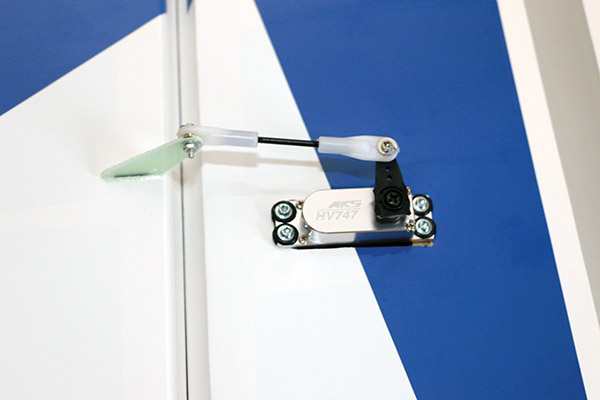
The MKS-747 HV servos, when coupled with running the Castle Creations Talon 90’s BEC in 8-volt mode, provide plenty of torque and zip to the control surfaces, and the beveled edges combine for extreme 3-D capability.
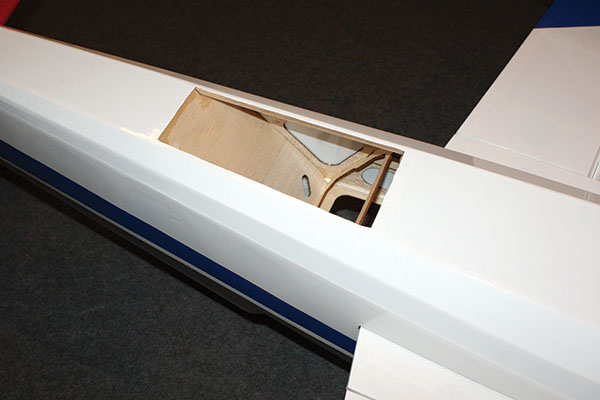
A ventilation hole is provided so that cooling air for the motor and ESC passes smoothly over the components and out the bottom of the airplane.
The ailerons use CA hinges, and the slots for the hinges are precut and line up where they should. The hinges were installed using thin ZAP adhesive. PAU provided G-10 fiberglass control horns, which were prepared by scuff sanding the shine off the gluing areas and securing them with 15-minute Z-Poxy. Because the installation is identical, I prepared and installed all four of the control horns at the same time. Instead of Z-bends or clevises, all of the pushrods on the Extra feature ball links on the servo arm and control horn. When combined with the stiff G-10 control horns, these make for a precise and slop-free control system. The tail was assembled next. The servos were mounted as previously detailed. The elevators were inserted in the fuselage slot and rotated into position. The elevator surfaces appear to be approximately 65% of the total horizontal area so 3-D flight won’t be a problem! The horizontal stabilizer is dry fitted and aligned with the wing. Measurements were taken from wingtip to stabilizer tip on each side and the stabilizer was adjusted until it was square. Many kits that I have assembled require either sanding the saddle or shimming the stabilizer, but the PAU Extra 300SP’s horizontal stabilizer was precisely aligned with the wing when looking from 5 feet behind the model. The stabilizer was marked and glued in place with 15-minute Z-Poxy and the elevators were hinged using the provided CA hinges. While the glue was drying on the stabilizer, the tail wheel wire was scuffed with 80-grit sandpaper and glued into the rudder. The rudder was hinged using CA hinges and thin Zap CA, and the ball link pushrods were sized and installed for the elevator and rudder. The carbon-fiber landing gear was bolted to the fuselage with the provided hardware and each bolt received a drop of Z-42 threadlocker. The wheel pants are held in place by the axle nut, and a small Phillips screw prevents them from rotating. I elected to use a PAU motor that is sold with the Extra. It’s a 540 Kv .60-size motor that is manufactured by Scorpion. The motor bolted right on and was connected to a Castle Creations Talon 90 ESC.
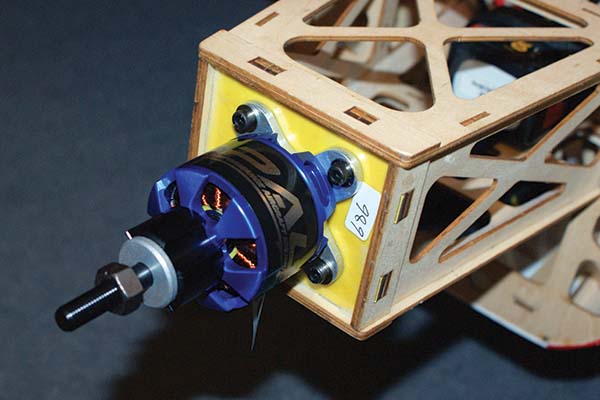
Made by Scorpion for PAU, the 540 Kv 6S motor is a perfect match for the Extra because it mounts right up and has plenty of power.
The Talon has a built-in BEC capable of supplying 20 amps to the radio system and servos. Because the MKS servos are high voltage, I used a Castle Link to configure the BEC to deliver 8 volts to the servos. The ESC is attached to the bottom of the motor mount and the receiver is mounted on the flat structure under the canopy. The fiberglass cowl is stout without being heavy and the paint nicely matches the UltraCote. The cowl mounts with four small screws, and with the spinner backplate installed, it was fitted and taped into place. I was pleased to see after the holes were drilled and the screws were installed that not only did the spinner line up on the cowl, but all of the trim aligned as well. The AR6600T receiver was mounted and bound to my DX-18, and Taildragger RC heavy-duty extensions were used to complete the servo installation. High rates were set for full throw, 70% mid-rate, and low rates were set to 40%.
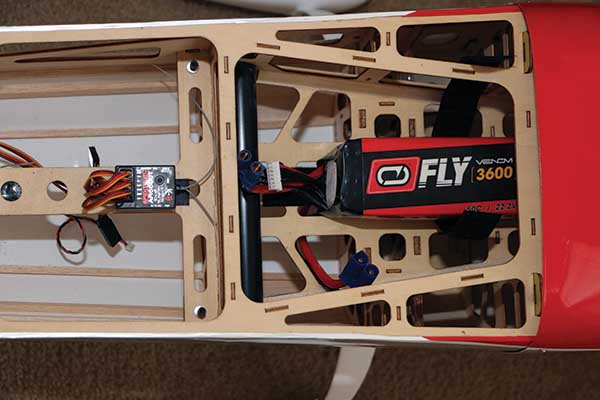
The AR6600 Spektrum receiver, combined with the author’s DX18 radio, offers integrated telemetry. The Venom 50c battery provided plenty of punch for 3-D flight and consistent power for larger International Miniature Aerobatic Club-style aerobatics.
Exponential is largely a function of pilot preference, but mine was set at 45/35/30 respectively. I’ll adjust individual throws, rates, and exponential settings as I get a feel for the Extra and dial it in.
Flying
The PAU Extra 300SP can be transported in nearly any vehicle. Assembly at the field consists of sliding the wings onto the wing tube, plugging in two aileron extensions, and installing one M2.5 bolt on the retaining tab on each wing. The canopy/hatch has a quick-release latch that exposes a roomy compartment where you can install a flight battery with plenty of room to adjust the battery position and attain the proper CG. I started with my CG at the center of the wing tube. You have some leeway in battery choices. I flew the Extra with a LiPo battery weighing as little as a 6S 3,600 mAh to as heavy as a 6S 5,000 mAh battery. A 4,000 to 4,200 mAh LiPo battery pack would probably be the perfect blend of weight and flight time. With a 50C Venom LiPo battery pack installed, I ran a test with a wattmeter on a fully charged battery. The power system pulled 75 amps and produced a shade more than 1,500 watts, giving a power loading in the 250-watts-per-pound range. That’s plenty for spirited performance! While taxiing, the Extra tracked nice and straight, but it wanted to fly, so I held full up-elevator to keep some pressure on the tail wheel. On the paved runway, I slowly advanced the power and the tail came up almost immediately. It was flying in 15 feet. Some right rudder was needed to keep the takeoff run straight, but I used little because the large surface area of the rudder and fin quickly became effective. After a couple of clicks of elevator trim and a click of right aileron, I had the Extra flying straight and level hands off. Even in low rate, the controls were responsive, and in high rate the roll rate was slightly faster than a drill bit. At the center of the wing tube, the Extra is slightly nose-heavy, which is suitable for flying precision. Pilots who want to fly all-out 3-D will probably want to bump it back more. I spent a few battery packs working on precision aerobatics to get a feel for the response and personality of the Extra, keeping the rates in low and mid-rates. The recommended motor/ESC combination produces plenty of power so long, smooth uplines were performed with authority. Rolls are nearly axial and slow rolls look great with a little rudder and elevator correction. Point-roll stops are crisp, and snaps are clean and stop immediately when the controls are released, with no signs of over-rotating. Knife-edge pulls to the wheels slightly and is easily corrected in flight or can be mixed out with roughly 4% up-elevator. When I was comfortable, it was time for a little fun. The next battery packs were spent trying rolling harriers, flat and inverted spins, knife-edge spins, and blenders. A hint of wing rock was present when the Extra was flown post stall, but it was easily countered with some aileron. Hovering is done at roughly half stick. Full throttle will snatch the Extra out of a hover with gusto.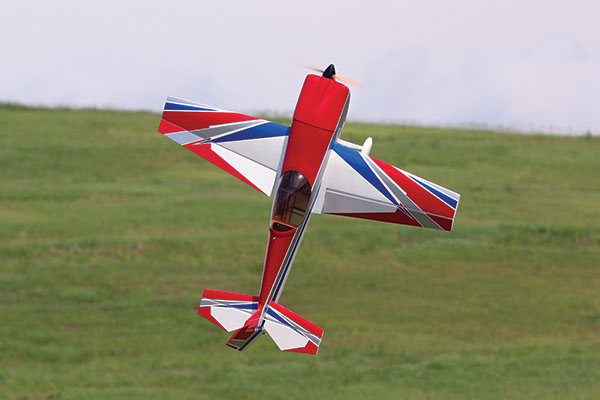
With the CG in the recommended location, hovering and torque rolls are easy to enter and maintain.
The large surfaces have plenty of control authority, and after you hit the sweet spot, it will spin like a top in a torque roll. After a couple of tries to get my timing right, I had the Extra doing pop tops with three or four flat rotations at the top. Fun! I used low rates for landing and the light wing loading allowed the Extra to touch down gracefully at a slow speed. You can land the Extra on the main wheels with a little power or flare and do three-point landings all day long. The Extra came with Side Force Generators (SFGs) and I tried a few flights with them installed after the photos were taken. The SFGs eliminate any rock in harriers and allow the Extra to come straight down with full up-elevator and a few ticks of throttle. The SFGs slow the roll rate, but there’s more than enough throw for the aircraft to roll quickly—even with the SFGs installed.










Add new comment